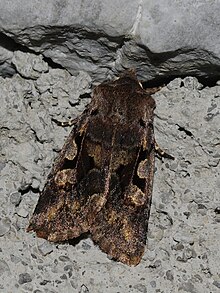bio.wikisort.org - Animal
The Hebrew character (Orthosia gothica) is a moth in the family Noctuidae. The species was first described by Carl Linnaeus in his 1758 10th edition of Systema Naturae. It is found throughout Europe.
| Hebrew character | |
|---|---|
 | |
| Scientific classification | |
| Kingdom: | Animalia |
| Phylum: | Arthropoda |
| Class: | Insecta |
| Order: | Lepidoptera |
| Superfamily: | Noctuoidea |
| Family: | Noctuidae |
| Genus: | Orthosia |
| Species: | O. gothica |
| Binomial name | |
| Orthosia gothica (Linnaeus, 1758) | |
Both the common and binomial names of this moth refer to distinctive black markings, one on each wing. These markings resemble the Hebrew letter nun (נ), and also a gothic arch.
Technical description and variation
The wingspan is 30–40 mm. Forewing sandy rufous, black speckled, median area generally deeper rufous: lines browner, forewing purplish red brown; the lines pale, ill defined, except by black spots at costa; the cell black; stigmata pale and large; claviform connected with outer line by a black bar; above which the base of vein 2 is often surrounded with rufous; hindwing fuscous. The size of the orbicular stigma is variable, and the amount and shape of the black filling in of the cell is determined by this variation; — in ab. gothicina H.-Sch. the black markings are replaced by olive brown or rufous; it is a northern form, occurring in Scotland, Scandinavia and Finland, and in the Tarbagatai Mountains; — askoldensis Stgr. [now full species Orthosia askoldensis] from Amurland and Japan has a more violet-grey ground colour; ab. pallida Tutt (22b) has a pale whitish ochreous ground colour; — in rufescens Tutt the reddish tint is predominant: - in rufa Tutt the ground colour is red; — and in brunnea Tutt the rufous tints give place to purplish brown.[1]
Biology
This moth flies at night in March and April (sometimes later) and is attracted to light and various flowers.

The larva are green dotted all over with yellow; dorsal and subdorsal lines yellowish white; spiracular line broad, white, with dark upper edge; head pale green. It feeds on a wide variety of plants (see list below). This species overwinters as a pupa.

Recorded food plants

- Alnus – grey alder
- Betula – birch
- Cannabis – hemp
- Centaurea
- Corylus – common hazel
- Epilobium – rosebay willowherb
- Filipendula ulmaria – meadowsweet
- Hieracium – hawkweed
- Humulus – hop
- Lythrum – purple loosestrife
- Malus – apple
- Polygonatum – Solomon's seal
- Polygonum
- Populus – aspen
- Prunus
- Quercus – oak
- Ranunculus buttercup
- Rhamnus – buckthorn
- Ribes – currant
- Rubus – raspberry
- Rumex
- Salix – willow
- Saxifraga – saxifrage
- Sorbus – rowan
- Tilia - large-leaved lime
- Vaccinium – bilberry
See Robinson, G. S et al.[2]
Notes
- ^ The flight season refers to the British Isles. This may vary in other parts of the range.
References
- Seitz, A. Ed., 1914 Die Großschmetterlinge der Erde, Verlag Alfred Kernen, Stuttgart Band 3: Abt. 1, Die Großschmetterlinge des palaearktischen Faunengebietes, Die palaearktischen eulenartigen Nachtfalter, 1914
- Robinson, Gaden S.; Ackery, Phillip R.; Kitching, Ian J.; Beccaloni, George W.; Hernández, Luis M. (2010). "Search the database - introduction and help". HOSTS - A Database of the World's Lepidopteran Hostplants. Natural History Museum, London.
- Chinery, Michael (1986, reprinted 1991). Collins Guide to the Insects of Britain and Western Europe.
- Skinner, Bernard (1984). The Colour Identification Guide to Moths of the British Isles.
External links
- Kimber, Ian. "73.249 BF2190 Hebrew Character Orthosia gothica (Linnaeus, 1758)". UKMoths. Retrieved 30 June 2019.
- Savela, Markku. "Orthosia gothica (Linnaeus, 1758)". Lepidoptera and Some Other Life Forms. Retrieved June 30, 2019. Taxonomy
- Lepiforum e.V.
- De Vlinderstichting (in Dutch)
На других языках
- [en] Hebrew character
[ru] Совка готическая
Совка готическая[1] (лат. Orthosia gothica) — ночная бабочка из семейства совок.Другой контент может иметь иную лицензию. Перед использованием материалов сайта WikiSort.org внимательно изучите правила лицензирования конкретных элементов наполнения сайта.
WikiSort.org - проект по пересортировке и дополнению контента Википедии